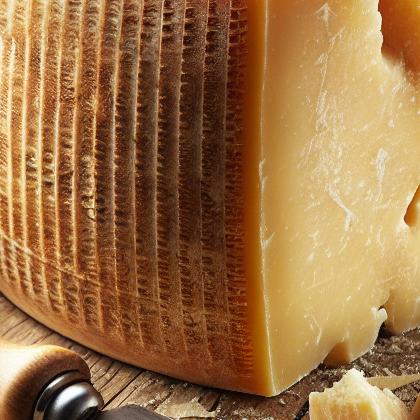Parmesan Cheese

Cheese is a food derived from milk that is produced in a wide range of flavors, textures, and forms by coagulation of the milk protein casein. It comprises proteins and fat from milk, usually the milk of cows, buffalo, goats, or sheep. During production, the milk is usually acidified, and adding the enzyme rennet causes coagulation. The solids are separated and pressed into final form. Some cheeses have molds on the rind or throughout. Most cheeses melt at cooking temperature.Hundreds of types of cheese from various countries are produced. Their styles, textures and flavors depend on the origin of the milk (including the animal's diet), whether they have been pasteurized, the butterfat content, the bacteria and mold, the processing, and aging. Herbs, spices, or wood smoke may be used as flavoring agents. The yellow to red color of many cheeses, such as Red Leicester, is produced by adding annatto. Other ingredients may be added to some cheeses, such as black peppers, garlic, chives or cranberries.For a few cheeses, the milk is curdled by adding acids such as vinegar or lemon juice. Most cheeses are acidified to a lesser degree by bacteria, which turn milk sugars into lactic acid, then the addition of rennet completes the curdling. Vegetarian alternatives to rennet are available; most are produced by fermentation of the fungus Mucor miehei, but others have been extracted from various species of the Cynara thistle family.Cheese is valued for its portability, long life, and high content of fat, protein, calcium, and phosphorus. Cheese is more compact and has a longer shelf life than milk, although how long a cheese will keep may depend on the type of cheese; labels on packets of cheese often claim that a cheese should be consumed within three to five days of opening. Generally speaking, hard cheeses last longer than soft cheeses, such as Brie or goat's milk cheese. Cheesemakers near a dairy region may benefit from fresher, lower-priced milk, and lower shipping costs. The long storage life of some cheese, especially if it is encased in a protective rind, allows selling when markets are favorable.A specialist seller of cheese is sometimes known as a cheesemonger. Becoming an expert in this field requires some formal education and years of tasting and hands-on experience, much like becoming an expert in wine or cuisine. The cheesemonger is responsible for all aspects of the cheese inventory: selecting the cheese menu, purchasing, receiving, storage, and ripening.
Parmesan Cheese Pairs With:

Parmesan Cheese Properties:
| Food Property | Type | Description |
|---|---|---|
| Flavor Profile | Salty | Parmesan cheese is known for its salty flavor profile, which adds a savory taste to dishes. |
| Umami | Parmesan cheese has a rich umami flavor, adding depth and complexity to dishes. | |
| Texture | Dryness | Parmesan cheese has a dry texture, making it crumbly and easy to grate over dishes. |
| Nutritional Value | Macronutrients | Parmesan cheese is high in protein and fat, making it a rich source of energy. |
| Color | Natural Pigments | Parmesan cheese has a pale yellow color due to the natural pigments in the milk used to make it. |
| Aroma | Volatile Compounds | Parmesan cheese has a strong, nutty aroma due to the volatile compounds produced during the aging process. |
| Chemical Composition | Acidity/Alkalinity (pH) | Parmesan cheese has a slightly acidic pH, which contributes to its tangy flavor. |
| Cooking Behavior | Heat Conductivity | Parmesan cheese melts easily when exposed to heat, making it perfect for adding to hot dishes. |
Food Pairing App - Version 1.2.0
